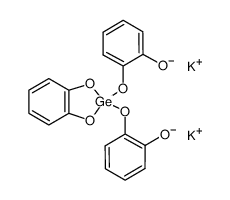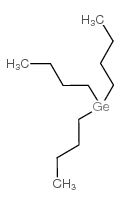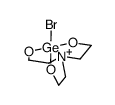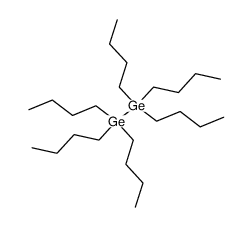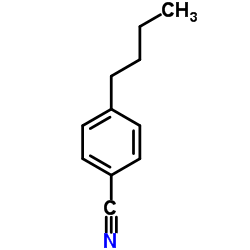1067-42-1
| Name | tetra-n-butylgermane |
|---|---|
| Synonyms |
TetrabutylgerMane
EINECS 213-929-3 Tetrabutyl germanium MFCD00015224 |
| Density | 0.93 g/mL at 25 °C(lit.) |
|---|---|
| Boiling Point | >100 °C(lit.) |
| Molecular Formula | C16H36Ge |
| Molecular Weight | 301.09700 |
| Flash Point | >230 °F |
| Exact Mass | 302.20300 |
| LogP | 6.63560 |
| Vapour Pressure | 0.000668mmHg at 25°C |
| Index of Refraction | n20/D 1.455(lit.) |
Synonym: Section 2 - COMPOSITION, INFORMATION ON INGREDIENTS
Risk Phrases: None Listed. Section 3 - HAZARDS IDENTIFICATION EMERGENCY OVERVIEW
The toxicological properties of this material have not been fully investigated. Potential Health Effects Eye: May cause eye irritation. Skin: May cause skin irritation. Ingestion: May cause irritation of the digestive tract. The toxicological properties of this substance have not been fully investigated. Inhalation: May cause respiratory tract irritation. The toxicological properties of this substance have not been fully investigated. Chronic: No information found. Section 4 - FIRST AID MEASURES Eyes: Flush eyes with plenty of water for at least 15 minutes, occasionally lifting the upper and lower eyelids. Get medical aid. Skin: Get medical aid. Flush skin with plenty of water for at least 15 minutes while removing contaminated clothing and shoes. Wash clothing before reuse. Ingestion: Never give anything by mouth to an unconscious person. Get medical aid. Do NOT induce vomiting. If conscious and alert, rinse mouth and drink 2-4 cupfuls of milk or water. Inhalation: Remove from exposure and move to fresh air immediately. If not breathing, give artificial respiration. If breathing is difficult, give oxygen. Get medical aid. Notes to Physician: Section 5 - FIRE FIGHTING MEASURES General Information: As in any fire, wear a self-contained breathing apparatus in pressure-demand, MSHA/NIOSH (approved or equivalent), and full protective gear. During a fire, irritating and highly toxic gases may be generated by thermal decomposition or combustion. Extinguishing Media: Use agent most appropriate to extinguish fire. Use water spray, dry chemical, carbon dioxide, or appropriate foam. Section 6 - ACCIDENTAL RELEASE MEASURES General Information: Use proper personal protective equipment as indicated in Section 8. Spills/Leaks: Clean up spills immediately, observing precautions in the Protective Equipment section. Sweep up or absorb material, then place into a suitable clean, dry, closed container for disposal. Provide ventilation. Section 7 - HANDLING and STORAGE Handling: Wash thoroughly after handling. Use with adequate ventilation. Avoid contact with eyes, skin, and clothing. Keep container tightly closed. Avoid ingestion and inhalation. Storage: Store in a tightly closed container. Store in a cool, dry, well-ventilated area away from incompatible substances. Section 8 - EXPOSURE CONTROLS, PERSONAL PROTECTION Engineering Controls: Facilities storing or utilizing this material should be equipped with an eyewash facility and a safety shower. Use adequate ventilation to keep airborne concentrations low. Exposure Limits CAS# 1067-42-1: Personal Protective Equipment Eyes: Wear appropriate protective eyeglasses or chemical safety goggles as described by OSHA's eye and face protection regulations in 29 CFR 1910.133 or European Standard EN166. Skin: Wear appropriate protective gloves to prevent skin exposure. Clothing: Wear appropriate protective clothing to prevent skin exposure. Respirators: A respiratory protection program that meets OSHA's 29 CFR 1910.134 and ANSI Z88.2 requirements or European Standard EN 149 must be followed whenever workplace conditions warrant respirator use. Section 9 - PHYSICAL AND CHEMICAL PROPERTIES Physical State: Liquid Color: colorless Odor: Not available. pH: Not available. Vapor Pressure: Not available. Viscosity: Not available. Boiling Point: > 100 deg C Freezing/Melting Point: Not available. Autoignition Temperature: Not available. Flash Point: > 110 deg C (> 230.00 deg F) Explosion Limits, lower: Not available. Explosion Limits, upper: Not available. Decomposition Temperature: Solubility in water: Specific Gravity/Density: .9300g/cm3 Molecular Formula: CH3(CH2)3!4Ge Molecular Weight: 301.06 Section 10 - STABILITY AND REACTIVITY Chemical Stability: Not available. Conditions to Avoid: Incompatible materials. Incompatibilities with Other Materials: Oxidizing agents. Hazardous Decomposition Products: Irritating and toxic fumes and gases. Hazardous Polymerization: Not available. Section 11 - TOXICOLOGICAL INFORMATION RTECS#: CAS# 1067-42-1 unlisted. LD50/LC50: Not available. Carcinogenicity: Tetrabutyl germanium - Not listed by ACGIH, IARC, or NTP. Section 12 - ECOLOGICAL INFORMATION Section 13 - DISPOSAL CONSIDERATIONS Dispose of in a manner consistent with federal, state, and local regulations. Section 14 - TRANSPORT INFORMATION IATA Not regulated as a hazardous material. IMO Not regulated as a hazardous material. RID/ADR Shipping Name: Not regulated. Hazard Class: UN Number: Packing group: Section 15 - REGULATORY INFORMATION European/International Regulations European Labeling in Accordance with EC Directives Hazard Symbols: Not available. Risk Phrases: Safety Phrases: S 24/25 Avoid contact with skin and eyes. S 28A After contact with skin, wash immediately with plenty of water. S 37 Wear suitable gloves. S 45 In case of accident or if you feel unwell, seek medical advice immediately (show the label where possible). WGK (Water Danger/Protection) CAS# 1067-42-1: No information available. Canada CAS# 1067-42-1 is listed on Canada's NDSL List. CAS# 1067-42-1 is not listed on Canada's Ingredient Disclosure List. US FEDERAL TSCA CAS# 1067-42-1 is listed on the TSCA inventory. SECTION 16 - ADDITIONAL INFORMATION N/A |
| Hazard Codes | Xn:Harmful; |
|---|---|
| Risk Phrases | R20/21/22 |
| Safety Phrases | S36 |
| WGK Germany | 3 |
| HS Code | 2931900090 |
|
~88% 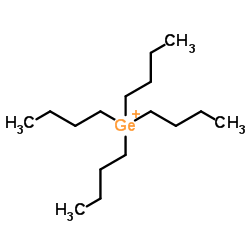
1067-42-1 |
| Literature: Cerveau, G.; Chuit, C.; Corriu, J. P.; Reye, C. Organometallics, 1991 , vol. 10, p. 1510 - 1515 |
|
~36% 
1067-42-1 |
| Literature: Organic and Biomolecular Chemistry, , vol. 2, # 4 p. 585 - 592 |
|
~87% 
1067-42-1 |
| Literature: Cerveau, G.; Chuit, C.; Corriu, R. J. P.; Reye, C. Organometallics, 1988 , vol. 7, p. 786 - 787 |
|
~0% 
1067-42-1 |
| Literature: Colacot, Thomas J. Journal of Organometallic Chemistry, 1999 , vol. 580, # 2 p. 378 - 381 |
|
~% 
1067-42-1 |
| Literature: Zeitschrift fuer Anorganische und Allgemeine Chemie, , vol. 174, p. 136 Journal of the American Chemical Society, , vol. 49, p. 2516 |
|
~63% 
1067-42-1 |
| Literature: Karlov, Sergey S.; Shutov, Pavel L.; Akhmedov, Novruz G.; Seip, Markus A.; Lorberth, Joerg; Zaitseva, Galina S. Journal of Organometallic Chemistry, 2000 , vol. 598, # 2 p. 387 - 394 |
|
~59% 
1067-42-1 |
| Literature: Karlov, Sergey S.; Shutov, Pavel L.; Akhmedov, Novruz G.; Seip, Markus A.; Lorberth, Joerg; Zaitseva, Galina S. Journal of Organometallic Chemistry, 2000 , vol. 598, # 2 p. 387 - 394 |
|
~% 
1067-42-1 |
| Literature: Journal of Solid State Chemistry, , vol. 184, # 9 p. 2345 - 2352 |
| Precursor 6 | |
|---|---|
| DownStream 8 | |
| HS Code | 2931900090 |
|---|---|
| Summary | 2931900090. other organo-inorganic compounds. VAT:17.0%. Tax rebate rate:13.0%. Supervision conditions:AB(certificate of inspection for goods inward,certificate of inspection for goods outward). MFN tariff:6.5%. General tariff:30.0% |
